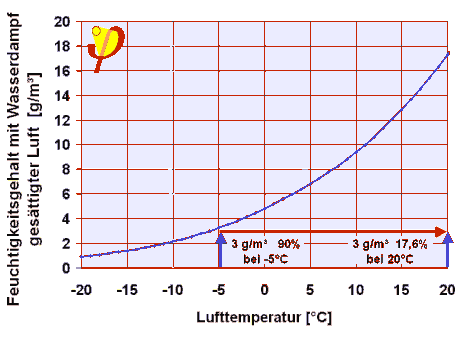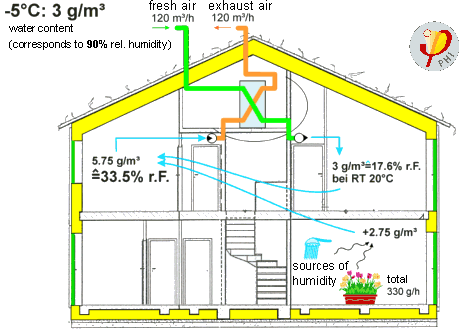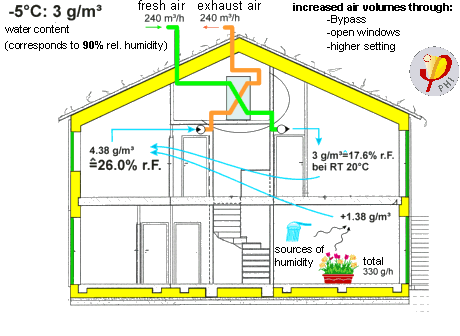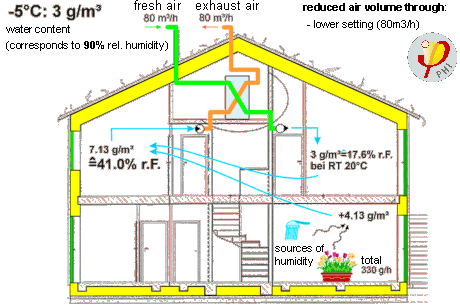Table of Contents
Air volumes
Too much air is also undesirable!
How much air is acceptable?
With a ventilation system whose output is based on the number of people (30 m³/h per person), there are hardly any complaints about poor air quality. However, if the air gets too dry due to excessive air volumes, people tend to complain.
Scientific studies have been carried out regarding additional ventilation through windows in Passive Houses during the heating period. Although this still occurs sometimes, it is becoming less and less common (as it is an old habit from the times when the occupants still lived in their old homes without ventilation systems), therefore it is not energy-relevant or practical!
Of course, it is possible to transfer even more air – and in theory, in the case of unlimitedly high air change rates, to achieve the quality of the external air, but in reality, noise caused by the air flow and draughts would have a restrictive effect (apart from the energy expenditure for transporting the air and the ventilation heat losses). Low indoor air humidity is the primary limiting factor if no humidification is planned for (increased effort for maintenance, hygiene and energy; see section about ventilation/humidity).
Adjustment of the air volumes by the user

In principle, it makes sense to allow occupants to control the air volumes according to the presence and number of people.
- Experience with operation and evaluations of measured data (e.g. evaluation of the switch position during operation in the multi-storey building in Kassel Marbachshöhe) have shown that the systems are almost always operated at the “Normal” setting in spite of the fact that it is possible for occupants to change the setting.
- Even in single-family houses, the air volumes are only adjusted for longer periods of absence.
Nevertheless, this doesn't mean that there is no need for a three-stage switch (the
purge ventilation level “Party Ventilation” should automatically return to the “Normal” setting after 30-45 minutes, the “Minimal” setting should ensure the minimum air changes of 0.31/h)).
Automatic adjustment of air volumes?
As early as 1991, in the first Passive House in Darmstadt Kranichstein a moisture and CO2-controlled ventilation system with air volumes shifting between the ground floor and the sleeping area in the upper floor was installed and operated; the objective was to reduce air volumes while optimising air quality at the same time.
The conclusion from today's perspective: it is not practically relevant, too much maintenance is required and it is too expensive. Of course, it is entirely possible that with clever ideas and new technologies, much better results can be achieved, but improved systems haven’t yet become available on the market.
Planning and dimensioning the system – over-dimensioning can lead to problems for lower air volumes!
First of all, the linear characteristics of the ducting network have to be determined by dimensioning the duct cross-sections and the loss of pressure including that of all installations.
- Based on these linear characteristics, a device is chosen with certain linear characteristics for the fan (based on a shell chart = “pressure/flow rate chart with equal fan efficiency areas” with the highest possible efficiency for average continuous operation).
- The device must still be able to transport the air flows necessary for purge ventilation (not with maximum efficiency as the operation periods in the purge ventilation mode are relatively short), and it must also be possible to achieve the minimum output of 0.3 1/h.
This is exactly what the problem is with over-dimensioning: even modern devices only have a limited control range and feature a certain minimum air flow rate (this is higher with larger units). The upper and lower limits are therefore relevant when dimensioning/choosing the device. The device should have the highest possible fan efficiency for continuous operation.
More is better? In the case of ventilation – not necessarily!
The size of the unit should be chosen carefully so that even small air flow rates can be transported and the air volumes should be dimensioned to remove not only pollutants but also to get rid of moisture from humidity sources. In contrast, the dimensioning of ducts and installations will only be limited by the costs and the space requirements. With a duct length of about 1 Pa/m in normal operation mode, it is possible to reach a good compromise - the system will be even more efficient with smaller air flows.
Future developments
In the future, ventilation systems will become even better with regard to user comfort, efficiency and costs; even today these systems are well-engineered and constitute the main components for providing comfort and good air quality in modern (or refurbished) buildings.
Air volumes and air humidity are closely related
The level of relative indoor air humidity in internal spaces depends substantially on both of the following influencing parameters:
- the intensity of the internal humidity sources (e.g. plants, cooking, drying clothes,…),
- the amount of fresh air supplied from outside.
The water vapour from internal sources of humidity is diluted with the fresh incoming external air. It makes no difference whether the external air enters through gaps, windows or a ventilation system (as long as no humidification or dehumidification takes place), or whether the air is heated (e.g. by a heat recovery system) – the mass of the water content in the air flow does not change in any of these situations.
With “normal ventilation”
This diluting effect is even greater in the winter as cold external air only contains a very small amount of water vapour (for example, at -5°/90% only about 3 g per cubic metre of air, see following illustration).
If this cold air enters the room and is warmed to 20°C, then its relative humidity will only be 17.6% - as long as additional water vapour from internal sources is not added to the indoor air. With ordinary moisture sources in the household (330 g/h – varying individually) and “standard“ ventilation (120 m³/h in the example - DIN 1946 is applicable here), a relative indoor air humidity of 33.5 % results under these conditions. Usually, this level is comfortable enough if the air is reasonably clean (containing less dust).
The greater the incoming quantity of external air is, the lower the relative indoor air humidity will be inside.
With “increased ventilation”
Low indoor air humidities
With standard ventilation, if the occupants perceive the air humidity to be too low, this can be easily remedied: reducing the external air flow increases the relative indoor air humidity because the water vapour from humidity sources will be less diluted. In the example above, if we reduce the amount of external air to 80 m³/h in the cold period – which is still admissible and still provides an adequate indoor air quality – then the indoor air humidity increases to about 41%.
Air changes will then be only about 0.25 h-1, based on the whole house, but as the building is being constantly supplied with fresh air, the air quality is still adequate. The air change rate should not be less than about 0.25 h-1 unless there are no residents in the house and it is intended to pre-flush the house with fresh air before the next “usage period” (which is an effort which we do not recommend for homes). These recommendations are the results of experiences with the measurement of the air quality in the Passive House in Darmstadt-Kranichstein over many years.
No-one should have to ventilate beyond their comfort level in terms of air humidity.
- Conventional ventilation designers tend to dimension the air volumes of home ventilation systems as rather high. At times, air change rates of 0.5 or even 0.8 are considered to be necessary, - especially in order to keep the indoor air humidity low in winter, thus reducing the risk of condensation and the associated mould growth.
- In Passive Houses, both problems do not occur anyway, because due to the good level of thermal protection, all interior surfaces of external components are so warm that even at 60% indoor air humidity, condensation cannot occur. Therefore, the external air quantity can be decreased slightly in cold periods, particularly if indoor air humidity is felt to be too low by the occupants. Ventilation system air changes between 0.3 and 0.4 are “reference values”. For Passive Houses we generally recommend that air volumes should be based on these lower values, so that with good air quality, the indoor air humidity also remains within the comfortable range.
Remedying low indoor air humidities:
- Adjust air volumes to lower levels
- Add sources of moisture in the living areas (e.g. plants)
- Keep the home as dust-free as possible: clean more often using a vacuum cleaner equipped with a fine dust filter.
Incidentally, practically dust-free air is not perceived as being “too dry” even with very low indoor air humidities; cold air at high altitudes usually feels good. However, the air in homes cannot be kept dust-free with reasonable effort, therefore, the lower limit for the relative indoor air humidity is at about 30%. Humidity levels below 30% are usually regarded as too dry, also from medical point of view (for further reading about physiological impairments at low indoor air see here. In this case, only points 1 and 2 as given above will be helpful. With indoor air that is still perceived as sufficiently “humid”, if the external air volumes become too low for maintaining an otherwise good quality of indoor air, a further technical solution would be to use separate air humidifiers, which must however be cleaned regularly.



